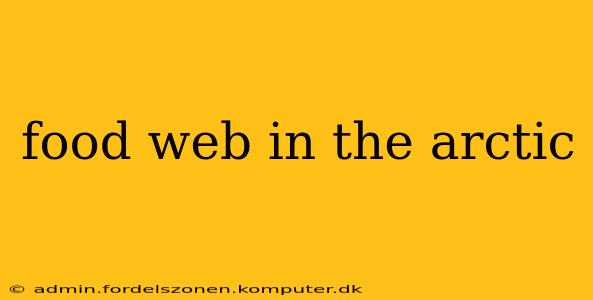The Arctic, a land of ice and snow, harbors a surprisingly complex and interconnected food web. This ecosystem, characterized by harsh conditions and limited resources, relies on a delicate balance between producers, consumers, and decomposers. Understanding this intricate network is crucial for appreciating the fragility of the Arctic environment and the impact of climate change. This post will delve into the key components of the Arctic food web, exploring the relationships between organisms and the challenges they face.
What are the main producers in the Arctic food web?
The foundation of any food web lies in its producers, the organisms that create their own food through photosynthesis. In the Arctic, this role is primarily filled by phytoplankton, microscopic algae that thrive in the relatively nutrient-rich waters during the summer months. These tiny organisms form the base of the entire food chain, supporting a vast array of consumers. On land, lichens, a symbiotic partnership between fungi and algae, and mosses, play a crucial role as primary producers, providing sustenance for herbivores. While plant life is scarce compared to more temperate regions, these hardy species are vital to the Arctic's survival.
What are the main consumers in the Arctic food web?
Consumers are organisms that obtain energy by eating other organisms. The Arctic food web features a diverse range of consumers, categorized by their trophic level (feeding level).
Primary Consumers (Herbivores):
- Zooplankton: These tiny animals, like copepods and krill, feed directly on phytoplankton, forming a crucial link between producers and higher trophic levels.
- Arctic Hare: A terrestrial herbivore that feeds on lichens, mosses, and other vegetation.
- Caribou/Reindeer: These grazing mammals are vital to the Arctic tundra ecosystem, consuming large quantities of lichens, grasses, and shrubs.
Secondary Consumers (Carnivores):
- Arctic Cod: A key fish species that feeds on zooplankton and smaller fish, serving as prey for many larger predators.
- Ringed Seal: A marine mammal that hunts fish and other marine invertebrates.
- Arctic Fox: A terrestrial predator that feeds on lemmings, birds, and carrion.
- Snowy Owl: A powerful avian predator that hunts lemmings, arctic hares, and other birds.
Tertiary Consumers (Apex Predators):
- Polar Bear: The apex predator of the Arctic, relying primarily on seals for sustenance. Their hunting success is directly linked to the health of the sea ice habitat.
- Orca (Killer Whale): While not strictly limited to the Arctic, orcas occasionally venture into Arctic waters and prey on seals and other marine mammals.
What are the main decomposers in the Arctic food web?
Decomposers play a vital role in recycling nutrients back into the ecosystem. In the Arctic, bacteria and fungi break down dead organic matter, releasing nutrients that are then utilized by producers. The cold temperatures slow down decomposition, leading to the accumulation of organic matter in the form of peat and permafrost.
How does climate change affect the Arctic food web?
Climate change poses a significant threat to the Arctic food web. Rising temperatures lead to sea ice loss, impacting the hunting grounds of polar bears and other ice-dependent species. Changes in sea ice also affect the distribution and abundance of phytoplankton, which in turn affects the entire food chain. Furthermore, warming temperatures can alter the timing of seasonal events, disrupting the delicate balance between predators and prey. The melting of permafrost also releases large amounts of methane and carbon dioxide, further accelerating climate change.
What is the impact of human activities on the Arctic food web?
Human activities, including pollution and overfishing, also pose a threat to the Arctic food web. Persistent organic pollutants accumulate in the tissues of Arctic animals, causing health problems and impacting their reproductive success. Overfishing of commercially important species can disrupt the balance of the ecosystem, leading to cascading effects throughout the food web.
What are some keystone species in the Arctic food web?
Keystone species are those that have a disproportionately large impact on their ecosystem relative to their abundance. In the Arctic, sea ice itself can be considered a keystone element, shaping the entire ecosystem. Polar bears and ringed seals are also considered keystone species due to their significant roles as apex predators and their influence on the populations of other animals.
The Arctic food web is a complex and interconnected system that is highly sensitive to environmental change. Understanding the intricate relationships within this ecosystem is critical for effective conservation efforts and ensuring the long-term health of this unique and vulnerable environment.
